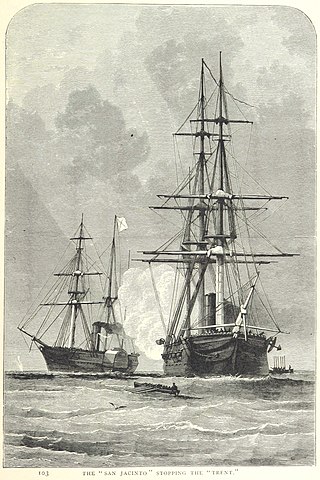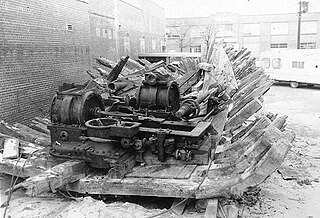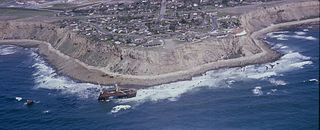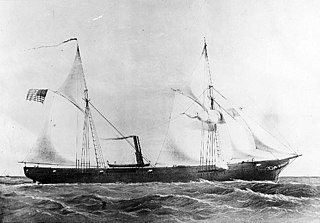Related Research Articles

The very first USS Hatteras was a 1,126-ton iron-hulled steamer purchased by the Union Navy at the beginning of the American Civil War. She was outfitted as a gunboat and assigned to the Union blockade of the ports and waterways of the Confederate States of America. During an engagement with the disguised Confederate commerce raider, CSS Alabama, she was taken by surprise and was sunk off the coast of Galveston, Texas. The wreck site is one of the few listed on the National Register of Historic Places because of its location away from destructive surf and because of the ship's side-wheel design, which marks the transition between wooden sailing ships and steam-powered ships.

Harriet Lane was a revenue cutter of the United States Revenue Cutter Service and, on the outbreak of the American Civil War, a ship of the United States Navy and later Confederate States Navy. The craft was named after the niece of senator and later United States President, James Buchanan; during his presidency, she acted as First Lady. The cutter was christened and entered the water for the Revenue Service in 1859 out of New York City, and saw action during the Civil War at Fort Sumter, New Orleans, Galveston, Texas, and Virginia Point. The Confederates captured her in 1863, whereupon she was converted to mercantile service. Union forces recaptured her at the end of war. The U.S. Navy declared her unfit for service and sold her. New owners out of Philadelphia renamed her Elliot Ritchie. Her crew abandoned her at sea in 1881.

The first USS San Jacinto was an early screw frigate in the United States Navy during the mid-19th century. She was named for the San Jacinto River, site of the Battle of San Jacinto during the Texas Revolution. She is perhaps best known for her role in the Trent Affair of 1861.

USS Kennebec was a Unadilla-class gunboat built for the U.S. Navy following the outbreak of the American Civil War. She was named for the Kennebec River.

Valbanera was a steamship operated by the Pinillos Line of Spain from 1905 until 1919, when she sank in a hurricane with the loss of all 488 crew and passengers aboard. Valbanera was a 400-foot-long (120 m) steamer capable of carrying close to 1,200 passengers. She sailed a regular route between Spain and Puerto Rico, Cuba, and the Gulf Coast of the United States. The ship sank with the loss of all 488 people on board during the Florida Keys Hurricane in September 1919.
The Denbigh was a paddle steamer built in 1860 by John Laird, Son, and Company at Birkenhead. She initially sailed between Liverpool and Rhyl, north Wales but was later sold an used as a blockade runner before being destroyed in 1865.

CSS Chattahoochee was a twin-screw steam powered gunboat built at Saffold, Georgia; she was christened for the river upon which she was built. The gunboat entered Confederate States Navy service in February 1863.

SS Dominator, a freighter, ran ashore on the Palos Verdes Peninsula in the South Bay area of California in 1961 due to a navigational error while lost in fog. Its remains can still be seen today and serves as a point of interest for hikers and kayakers.

USS Bienville was a 1,558 long tons (1,583 t) (burden) wooden side-wheel paddle steamer acquired by the Union Navy early in the American Civil War. She was armed with heavy guns and assigned to the Union blockade of the waterways of the Confederate States of America.
USS Fox was a captured Confederate schooner acquired by the Union Navy from the prize court during the American Civil War.
USS Nita was a captured Confederate steamer acquired by the Union Navy from the prize court during the American Civil War. She was put into service by the Union Navy to patrol navigable waterways of the Confederacy to prevent the South from trading with other countries.

USS Kanawha was a Unadilla-class gunboat built for the Union Navy during the American Civil War. She was used by the navy to patrol navigable waterways of the Confederacy to prevent the South from trading with other countries.

USS Isaac Smith was a screw steamer acquired by the United States Navy during the American Civil War. She was used by the Union Navy to patrol navigable waterways of the Confederate States of America to prevent the Confederacy from trading with other countries. In 1863, she became the only warship in the American Civil War to be captured by enemy land forces. She then served in the Confederate States Navy as CSS Stono until she was wrecked.
USS Tristram Shandy was a 444-ton steamer and blockade runner captured by the Union Navy during the American Civil War.
USS Amanda was a bark acquired by the Union Navy during the American Civil War.

USS Antona was a steamer captured by the Union Navy during the American Civil War. She was used by the Union Navy as a dispatch boat and gunboat in support of the Union Navy blockade of the Confederate States of America.
USS Sidney C. Jones was a schooner that served in the Union Navy during the American Civil War. Built in East Haddam, Connecticut, and launched in April 1856, Sidney C. Jones was intended to be used on trade routes. In October 1861, she was purchased by the Union Navy for military service. Originally intended for service on the Union blockade, she was later converted into a mortar schooner and was armed with a mortar and four other cannons. In April 1862, she participated in the bombardment of Confederate positions at Fort Jackson and Fort St. Philip. During July, she ran aground while part of a force bombarding Vicksburg, Mississippi, and was blown up by her crew to prevent capture on July 15.
USS Isilda, sometimes spelled Ezilda, was an armed schooner in commission in the United States Navy from 1861 to 1863. As part of the Union Navy, she saw service during the American Civil War.

Adriatic was a three-masted, two deck, packet ship built in 1861 by Curtis & Tilden, Boston, Massachusetts, United States. On August 12, 1864, Adriatic was embarked from London, England en route to New York City carrying 163 German immigrants and 100 US citizens. She made it as far as the New Jersey coast before meeting the Confederate raider CSS Tallahassee, which collided with her. Captain John Taylor Wood of Tallahassee ordered every passenger on Adriatic to be taken prisoner and put on Tallahassee. Wood then ordered Adriatic burned.
References
- Gaines, W. Craig, Encyclopedia of Civil War Shipwrecks, Louisiana State University Press, 2008. ISBN 0-8071-3274-8